In Illumination: From Divine to Sacred | From Drinking to Savoir-boire | From Vineyard to Port
From Vineyard to Harvest, and from Cellar to Port

THE VERY RICH HOURS OF THE DUKE OF BERRY, CALENDAR, MARCH
(TRÈS RICHES HEURES DU DUC DE BERRY, CALENDRIER, MARS)
Barthélémy d'Eyck, ca. 1440
Musée Condé, Chantilly, France
The Très Riches Heures du duc de Berry was the culmination of a project spanning more than 80 years. It was commissioned by the Duke of Berry from the de Limbourg brothers around 1410-11. Left unfinished when the three painters and their sponsor died in 1416, some of the manuscript’s miniatures were probably completed in the 1440s by an anonymous painter, whom some art historians believe to have been Barthélemy d’Eyck. In 1485-89, the work was completed by the painter Jean Colombe on behalf of the Duke of Savoy. This illumination is included in the first and most famous part of the manuscript: the calendar. The month of March is illustrated by the agricultural labour carried out at the end of winter. Each field contains a different part of the work; all are separated by paths which cross at a monument known as a ‘montjoie’. In the foreground, a peasant works in a cornfield. He is driving a two-wheeled plough, pulled by two cows, with the help of a long stick. In an enclosure on the right, vineyard workers are pruning a mass of vines and tilling the soil with a hoe to aerate it. March has always been the best month for pruning.
> Pour agrandir l'oeuvre, cliquez sur l'image
On the right, a man is hunched over a bag; doubtless it contains seeds for sowing. In the background, a shepherd is accompanied by his sheepdog. The Chateau de Lusignan, in the Poiteau region of France, dominates the scene. The castle was modernised by the Duc de Berry, its owner. To the right of the image, above one of the towers, flies a winged dragon representing the fairy Melusine. In 1392, Jean d’Arras wrote the Noble histoire de Lusignan, also known as the Roman de Mélusine, for Jean de Berry. It is the story of the fairy, an imaginary ancestor of the Duc de Berry. According to legend, Mélusine gave birth to the Lusignan bloodline and built the fortress. The wife of Raymondin de Lusignan, she promised him wealth and happiness, on the condition that he must never see her on Saturdays, when she took on the appearance of a dragon. One day, Raymondin broke his promise and watched his wife bathing. Thus unmasked, the fairy fled.
A Book of Hours is a liturgical book aimed at Catholic laymen – unlike a breviary, written for clerics – which allows the reader to follow the liturgy of the Hours. In addition to prayers written for every hour of the day, the Book of Hours usually includes a calendar which follows the evolution of the liturgy throughout the year. It was the most popular type of illuminated document, though not all manuscripts were illustrated. Such documents provide important information about life at the end of the Middle Ages and are a source of Medieval Christian iconography.
During the Middle Ages, vines surrounded towns and cities almost regardless of climate. This proximity was doubtless a means of avoiding transporting the wine, which was subject to heavy taxes and the various hazards of the period. People only drank wine produced in their local area. Anything was preferable to water! Viticulture is very widely represented in illuminations – the only iconography of the time to show genre scenes.
IN THE VINEYARDS
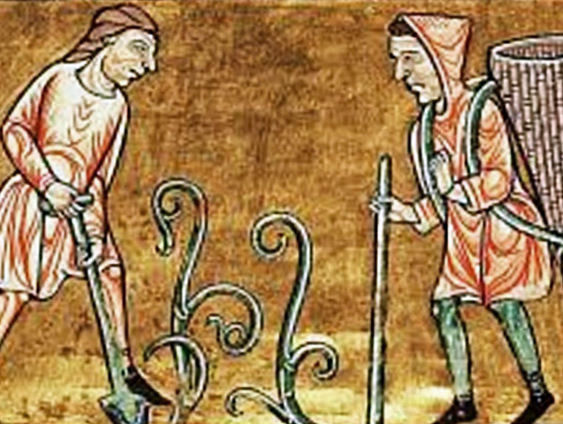
GRAPE VINES' PLANTATION Weinbau Pslater, March, 1180 / 1
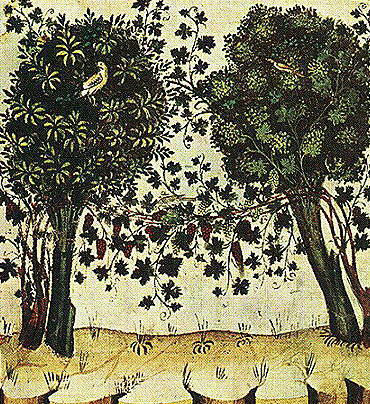
VINES TRAINED TO GROW UP TREE TRUNKS FOR SUPPORT Tacuinum Sanitatis, 1474 - BnF, Paris / 2
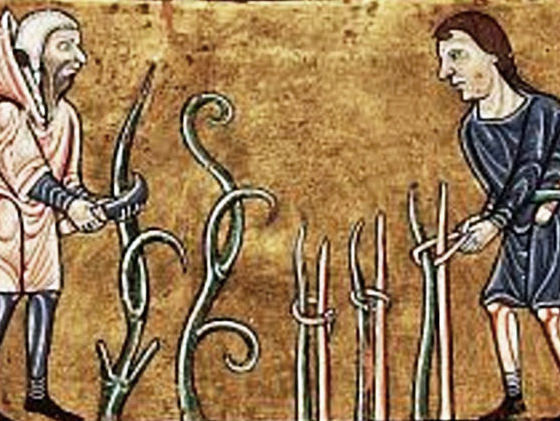
PRUNING Weinbau Pslater, March, 1180 / 3

PRUNING THE VINE Agronomy book, March Pietro de Crescenzi, 1459 - Condé Museum, Chantilly, France / 4

PRUNING ca. 1478/80 - British Library, London / 5

THE MONTH OF MARCH Grimani Breviary, 1490-1510 Biblioteca Nazionale Marciana, Venice, Venice, Italy / 6
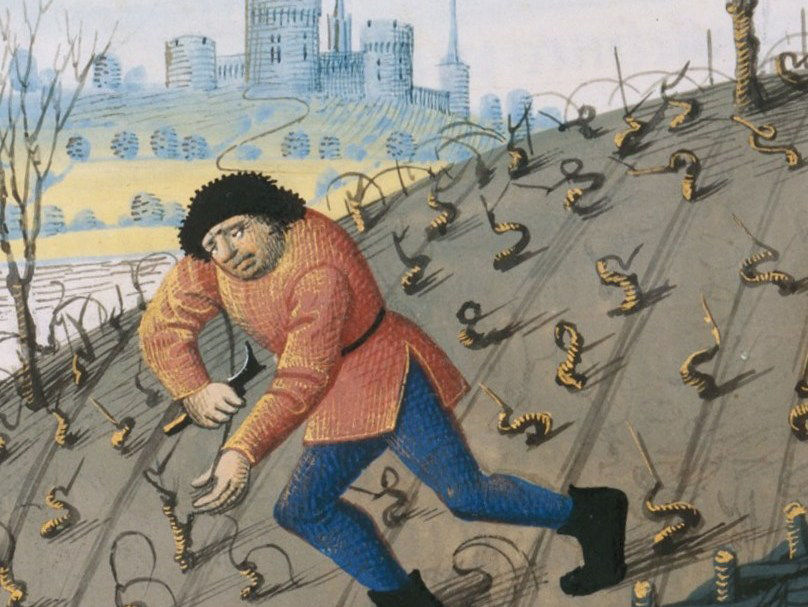
SPRING Livre des propriétés des choses, 1480 - BnF, Paris / 7
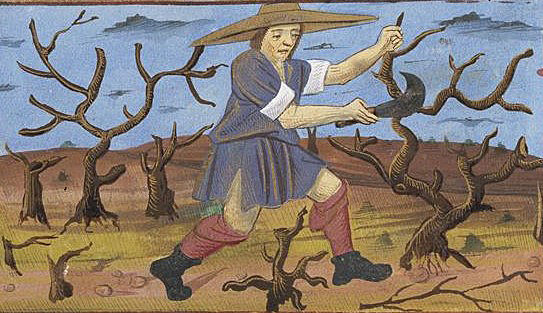
PRUNING, MARCH Missel de l'abbaye de Montierneuf, ca. 1485? - BnF, Paris / 8
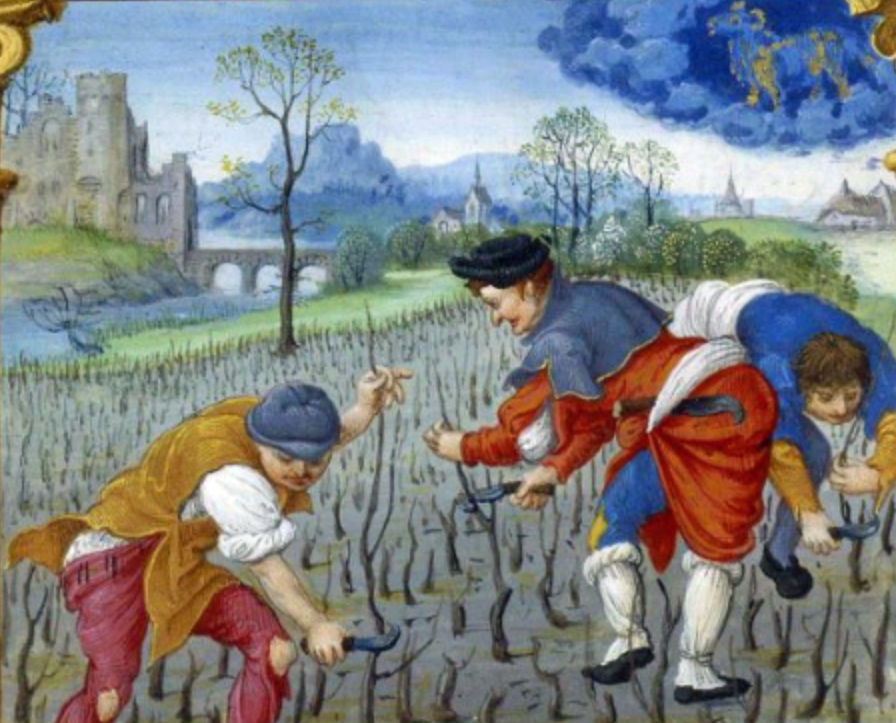
PRUNING, THE MONTH OF MARCH Heures de Catherine de Médicis, 1500?-1550? - BnF, Paris / 9
> Click on the icons for a closer look at the artworks
1 to 9. March and September marked the two biggest moments of the year: the pruning of the vine and the harvest. Sometimes these tasks overflowed into the months of April (late pruning), August (harvest and winemaking preparations) and October (late harvest and/or pressing of the grapes). The end of the winter was also the moment of planting (Weinbau Psalter) and building up the earth (Bréviaire Grimani). Today, this latter task is carried out in November or December. For vineyards built on slopes and subject to water flows, the vines planted on the summit of hills tend to shift; the surrounding soil needs to be built back up.
4. Pietro de' Crescenzi’s Book of Rural Benefits illustrates the vine pruning process. This was done with a wide-bladed knife. The worker, stooping forward, grabs the vine shoot above the blade, which he is holding in his right hand. In the background, another peasant carries out the same task, kneeling to reach the lowest branches..
THE GRAPE HARVEST
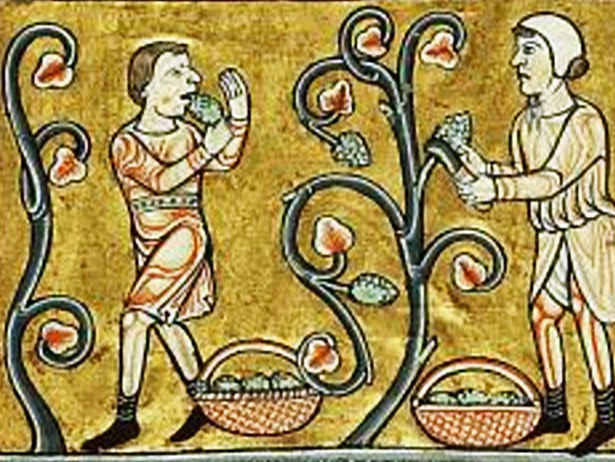
HARVEST Weinbau Psalter, 1180 - The Hague / 1

HARVEST Miracles de Notre-Dame 13 th century (third quarter) - City Library, Besançon, France / 2

TREADING OF THE GRAPE Weinbau Psalter, 1180 - The Hague / 3
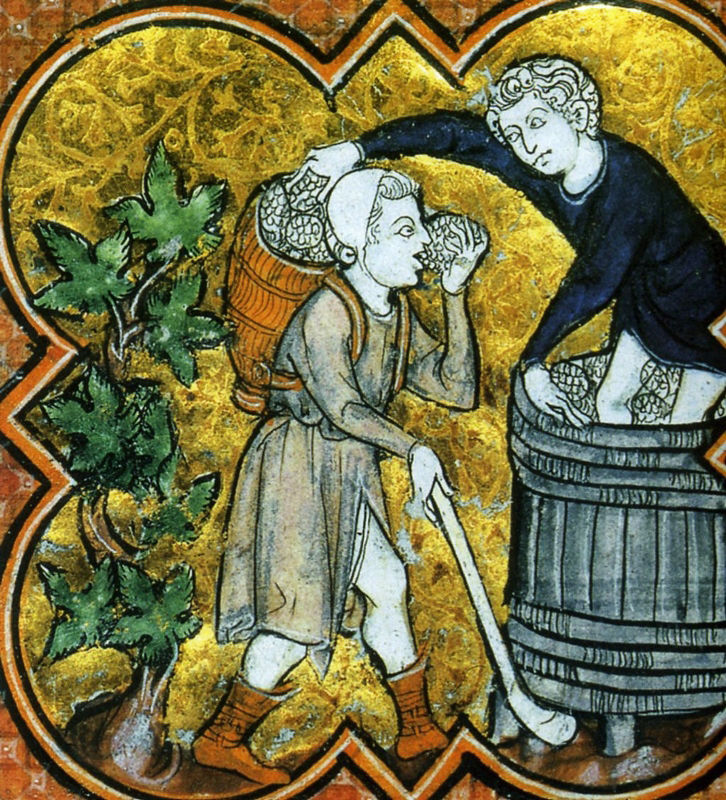
GRAPE CARRYING DURING HARVEST Martyrologe de St-Germain-des-Prés, 1270 - BnF, Paris / 4

LABOURS OF THE MONTH: SEPTEMBER Queen Mary Psalter, ca. 1310 - British Library, London / 5
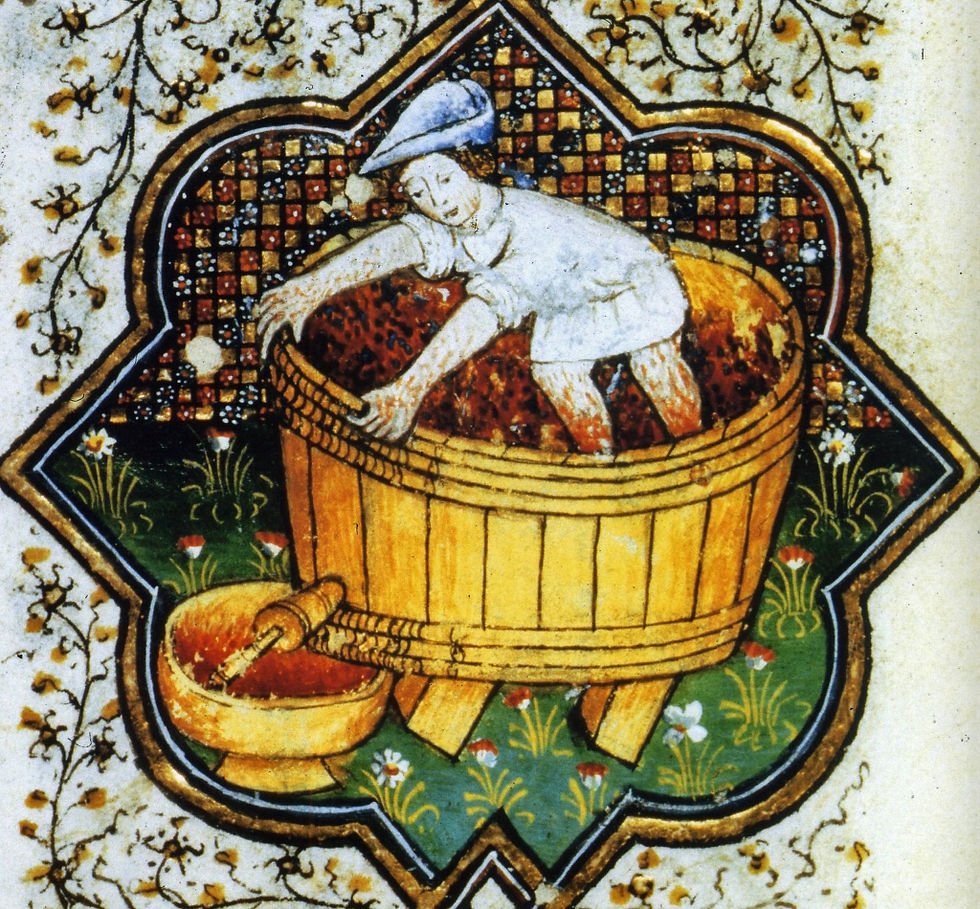
TREADING VAT Heures de Marguerite d'Orléans,1430 - BnF, Paris / 6

BARREL HOOPING Officium Beatae Mariae Virginis,1385 - Bologna, Italy / 7

BARRELS AND BRENTA Justinien, Digestum Vetus, Bologna, ca. 1345 - BnF, Paris / 8

MAN MAKING WINE, IN THE CALENDAR OF SEPTEMBER Psalter, France, ca. 1250 - British Library, Londres / 9

VINES CLIMBING ON PERGOLA 1385 - Bologna, Italy

AUTUMN Tacuinum Sanitatis, ca. 1390 - Munich, Germany

MEN MAKING WINE The Dunois Hours September, ca. 1440-1450 - British Library, London

HARVEST, TREADING, AND TOPPING-UP Grandes Heures de Rohan, October, 1430/35 - BnF, Paris

THE MONTH OF SEPTEMBER Grimani Breviary ca. 1510/20 - Biblioteca Nazionale Marciana, Venice, Italy

HARVEST IN CHATEAU D'HESDIN GARDENS Jean Mielot for the Duke Philippe le Bon, ca. 1460

TREADING AND WINE PRESSING Heures à l'usage de Rome, ca. 1510/25 - City Library, Rouen, France

HARVEST Hours for Cluny Abbey, ca. 1500 - City Library, Amiens, France

TREADING AND BARREL FILLING Livre d Heures Jean Marion, 1500 - Munich, Germany
> Click on the icons for a closer look at the artworks
FROM CELLAR TO PORT

MONK IN CHARGE OF THE CELLAR AND TASTING WINE Livre de Santé for Aldebrandino of Sienna, 14th century - BL, London

MONKEY DRAWING WINE Pontifical de Guillaume Durand ca. 1357 - Ste-Genevieve Library, Paris

TOPPING-UP Redevancier de St-Germain-des-Prés ca. 1530 - Archives Nationales, Paris, France

HARVEST, WINEMAKING, AND TASTING WITH MERCHANTS Livre d'heures, October, ca. 1540

MERCHANT, BUYING GRAIN AND WINE National Library, The Hague, The Netherlands

WINE MARKET AT THE PORT OF BRUGES Flemish calendar, October, ca. 1530 - Munich
> Click on the icons for a closer look at the artworks
GALLERIES IN ILLUMINATION
> Wine and Painting > In Illumination > From Vineyard to Port




